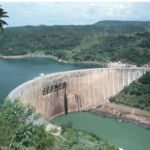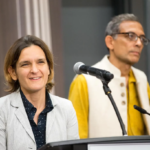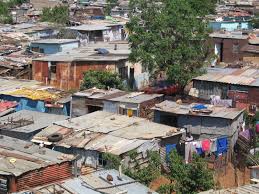KN Ramachandran
Introduction
the Communist forces the world over are observing the centenary of the October Revolution from 7th November, 2016, to 7th November, 2017, as part of their struggle for advancing the World Proletarian Socialist Revolution by drawing lessons from it. The international Coordination of Revolutionary Parties and Organizations (ICOR) have also called for observing it internationally. These programs are being organized when the International Communist Movement (ICM) is passing through a critical period. It is generally accepted among the Marxist-Leninist forces that the communist movement started facing severe challenges and setbacks, in the main, from the time of the 20th Congress of the CPSU in 1956 which embraced revisionist positions abandoning the socialist path. When the ICM and the Communist movement in different countries started confronting this crisis, utilising this opportunity the imperialist camp and its lackeys further intensified the counter revolutionary offensive against the revolutionary movement as a whole, which they had started right from the time the Communist Manifesto was published in 1848. Marx and Engels had introduced it with these words:”A specter is haunting Europe, the specter of Communism. All the powers of old Europe have entered in to a holy alliance to exorcise this specter”. When the ICM was facing crises and setbacks, especially after the disintegration of Soviet Union in 1991, these forces of the old world joined hands to ‘exorcise’ the Communist movement for ever in a more frenzied form, by screaming slogans like “end of history” and “socialism is dead”. The Communist movement can take significant steps forward only by recognizing the setbacks suffered, finding the reasons for them, making concrete analysis of the present situation, and by developing its theoretical orientation and practice according to present realities, taking lessons from the positive and negative aspects of the past experiences.
It is in this context the importance of the Resolution on Launching Theoretical Offensive for Communist Resurgence adopted by the Tenth Congress of the CPI (ML) Red Star in 2015 should be seen. It says: “What does such an offensive entail? (a) we have to undertake a thorough study and analysis to identify the causes of the collapse of the erstwhile socialist countries, especially Soviet Union and China; (b) we have to launch a vigorous ideological campaign to establish across society the superiority of communism over the present ruling system as well as against various alien tends; (c) we have to develop Marxism- Leninism on the basis of a concrete analysis of the concrete situation….” In the concluding paragraph it states: “…We must boldly seize the real questions before the people in today’s situation and must scientifically search out the solutions. We must unsparingly lay bare our own history, the history of the communists in India and all over the world…” It is based on this orientation the CPI(ML) Red Star has taken up the analysis of the various aspects of the experience of the October Revolution and of the socialist construction in Soviet Union. As part of this process, this paper focusses on the experience of the socialist construction in Soviet Union.
By the end of 17th century, the French Revolution had established the ideological motifs of the modern capitalist societies through its famous slogan: “liberty, equality, fraternity”. It laid the foundation for secularism and democracy based on universal suffrage. As a leap forward, the Paris Commune provided a proletarian stand point to break away from the capitalist path and to take up the socialist transition. Evaluating the lessons of the Paris Commune, Marx wrote:”The direct antithesis to the empire was the Commune. The cry of the “social republic” with which the February Revolution was ushered in by the Paris proletariat did but express a vague aspiration after a republic that was not only to supersede the monarchical form of class rule, but class rule itself. The Commune was the positive form of that republic”. Though the Commune was soon suppressed by the combined forces of the capitalist states, it had given a new fillip to the working class movement. Following October Revolution, while launching the socialist construction, the Bolsheviks led by Lenin tried to take of from the experience of Paris Commune.
In the present situation, when the ICM has suffered severe setbacks and the communists are trying to find the reasons for it, what were the positive contributions as well as the weaknesses in the socialist transition taken up in the Soviet Union calls for a serious study. Then only the role played these weaknesses and deviations in the degeneration of Soviet Union later to a bureaucratic state capitalist dictatorship and eventually to its disintegration can be correctly evaluated. Presently, what should be the revolutionary approach towards advancing socialist construction and the path of sustainable development taking lessons from these positive and negative experiences are questions of cardinal importance before the communists. It is with this perspective the evaluation of the experience of the socialist construction in the Soviet Union is attempted below.
Socialist transition in the Soviet Union
Soon after the success of the October Revolution, The Constituent Assembly was constituted which proclaimed Russia as a Republic of Soviets of Workers’, Soldiers’ and Peasants’ Deputies. All powers, centrally and locally, were vested in these Soviets. Besides this the Resolution stated: (1) The Russian Soviet Republic is established on the principle of a free union of free nations, as a federation of Soviet national republics. II. Its fundamental aim being to abolish all exploitation of man by man, to completely eliminate the division of society into classes, to crush the resistance of the exploiters, to establish a socialist organisation of society and to achieve the victory of socialism in all countries; (2) Private ownership of land is hereby abolished. All land together with all buildings, farm implements and other appurtenances of agricultural production, is proclaimed the property of the entire working people; (3) The Soviet laws on workers’ control and on the Supreme Economic Council are hereby confirmed for the purpose of guaranteeing the power of the working people over the exploiters and as a first step towards the complete conversion of the factories, mines, railways, and other means of production and transport into the property of the workers’ and peasants’ state. (4) The conversion of all banks into the property of the workers’ and peasants’ state is hereby confirmed as one of the conditions for the emancipation of the working people from the yoke of capital. (5) For the purpose of abolishing the parasitic sections of society, universal labour conscription is hereby instituted. (6) To ensure the sovereign power of the working people, and to eliminate all possibility of the restoration of the power of the exploiters, the arming of the working people, the creation of a socialist Red Army of workers and peasants and the complete disarming of the propertied classes are hereby decreed. Soon decrees were also issued to ensure equal wages for equal work and equal rights to women in all fields.
Expressing its firm determination to free mankind from the clutches of finance capital and imperialism, which in the most criminal of wars till then, the First World War, had drenched the world in blood, the Constituent Assembly endorsed the policy pursued by Soviet power of denouncing the secret treaties, organising most extensive fraternisation with the workers and peasants of the armies in the war, and achieving at all costs, by revolutionary means, a democratic peace between the nations, without annexations and indemnities and on the basis of the free self-determination of nations. With the same end in view, the Constituent Assembly insisted on a complete break with the barbarous policy of bourgeois civilisation, which has built the prosperity of the exploiters belonging to a few chosen nations on the enslavement of hundreds of millions of working people in Asia, Africa and Latin America, in the colonies in general, and in the small countries.
Thus the newly born socialist state confiscated the properties of the capitalist and landlord classes, brought the industries under the leadership of workers’ soviets, implemented revolutionary land reforms which established the control of ‘land to the tillers’ and took up the challenge of socialist construction mobilizing the masses. They were taken up combating the economic blockade of the imperialist forces and the backwardness of the economy of the pre-revolutionary Russia. It was a great beginning, very soon advancing towards fulfilling the basic requirements including food, clothing, housing, healthcare, education and employment for all. Along with this, significant victories were achieved in carrying forward the task of modernizing and developing the industry and agriculture, launching SU on the path of socialist transformation. For the first time in human history, the Five Year Plans were launched to organize the economy in the benefit of the toiling masses.
The Paris Commune gave a great example of how to combine initiative, independence, freedom of action and vigour from below with voluntary centralism free from stereotyped forms. So the orientation provided in SU was that the Soviets should follow the same road. The Soviets must work more boldly and display greater initiative. All “communes” — factories, villages, consumers’ societies, and committees of supplies, were asked to compete with each other as practical organisers of accounting and control of labour and distribution of products. The programme of this accounting and control were made simple, clear and intelligible to all — everyone to have bread; to have sound footwear and good clothing; to have warm dwellings; everyone to work conscientiously; not a single rogue to be allowed to shirk their work; not a single rich man who violates the laws and regulations of socialism to be allowed to escape the fate of the rogue, which should, in justice, be the fate of the rich man.
Two days after taking power in 1917 Lenin’s government issued the decree “On Land”. It declared all forests, waters, and subsoil minerals to be the property of the state and arrogated these resources to the states exclusive use. The government enacted a basic law “On Forests” [14 May 1918] provided for the creation of a Central Administration of Forests of the Republic to manage the forests on the basis of planned reforestation and sustained yield. The forests were divided into an exploitable sector and a protected one; the purposes of the latter included erosion control, protection of water basins, and significantly, “the preservation of monuments of nature”. Lenin argued: “In order to protect the sources of our resources, we must act in accordance with scientific-technical laws. For example, if the subject is the renting out of forests we must see to it that the forestry industry conducts itself properly. If we are talking about oil, then we must organise against spillage. This, it is necessary to enforce adherence to scientific-technical laws and to the principle of rational exploitation.”
For the Protection of Monuments of Nature, Gardens, and Parks, SU institutionalised the demand for Zapovednik, nature reserves that were also protected territories devoted to scientific research. On 4 May 1920 the first of them was created as the first protected territory anywhere to be created by a government exclusively in the interests of the scientific study of nature. By 1925 there were nine state zapovedniki with a gross area of nearly one million hectares, as well as fifteen local ones. In total, these reserves were larger than the Yellowstone National Park. By 1929 the USSR’s nature reserves had grown to sixty one. Territorially, their combined area had increased by nearly four times, to nearly 4 million hectares. This substantial increase was partially the result of the striking proliferation of local zapovedniki in this period; they increased to forty-six incorporating almost 2 million hectares.
As a result of all these steps, by 1930s when the whole imperialist camp was facing Great Depression and severe economic and political crisis, they did not affect the planned economy of the SU. All these great achievements through socialist construction, and the support extended by the Communist International (Comintern) formed in 1919 greatly inspired the national liberation movements in the Asian, African, Latin American countries. They helped the spread of Marxism all over the world.
Evaluating the results of the First Five year Plan Stalin wrote: “ the restoration and development of heavy industry, particularly in such a backward and poor country as ours is an extremely difficult task; for, as is well known, heavy industry calls for enormous financial expenditure and the existence of a certain minimum of experienced technical forces….. The Party knew how heavy industry had been built in Britain, Germany and America. It knew that in those countries heavy industry had been built either with the aid of big loans, or by plundering other countries, or by both methods simultaneously. The Party knew that those paths were closed to our country. What, then, did it count on? It counted on our country’s own resources. It counted on the fact that, with a Soviet government at the helm, and the land, industry, transport, the banks and trade nationalized, we could pursue a regime of the strictest economy in order to accumulate sufficient resources for the restoration and development of heavy industry. The Party declared frankly that this would call for serious sacrifices, and that it was our duty openly and consciously to make these sacrifices if we wanted to achieve our goal. The Party counted on carrying through this task with the aid of the internal resources of our country — without enslaving to credits and loans from abroad”. So, “as a result of all this the Soviet Union has been converted from a weak country, unprepared for defence, into a country mighty in defence, a country prepared for every contingency, a country capable of producing on a mass scale all modern means of defence and of equipping its army with them in the event of an attack from abroad”.
In the field of agriculture, the Soviet leadership proceeded from the fact that without collectivization it would be impossible to lead the country on to the high road of building the economic foundations of socialism, impossible to free the vast masses of the labouring peasantry from poverty and ignorance. In this connection, the task of the five-year plan in the sphere of agriculture was to unite the scattered and small, individual peasant farms, which lacked the possibility of using tractors and modern agricultural machinery, into large collective farms, equipped with all the modern implements of highly developed agriculture, and to cover unoccupied land with model state farms. The task was to convert the U.S.S.R. from a small-peasant and backward country into one of large-scale agriculture organized on the basis of collective labour and providing the maximum output for the market.
As Lenin had pointed out: “One may or may not be determined on the question of nationalisation or confiscation, but the whole point is that even the greatest possible ‘determination’ is not enough to pass from nationalisation and confiscation to socialisation. The misfortune of our ‘Lefts’ is that by their naive, childish combination of the words ‘most determined policy of socialisation’ they reveal their utter failure to understand the crux of the question, the crux of the ‘present’ situation. The misfortune of our ‘Lefts’ is that they have missed the very essence of the ‘present situation’ (the situation in a country under socialist transformation like SU- kn), the transition from confiscation (the carrying out of which requires above all determination in a politician) to socialisation (the carrying out of which requires a different quality in the revolutionary masses).
“Yesterday, the main task of the moment was, as determinedly as possible, to nationalise, confiscate, beat down and crush the bourgeoisie, and put down sabotage. Today, only a blind man could fail to see that we have nationalised, confiscated, beaten down and put down more than we have had time to count. The difference between socialisation and simple confiscation is that confiscation can be carried out by ‘determination’ alone, without the ability to calculate and distribute properly, whereas socialisation cannot be brought about without this ability.”
It is clear that Lenin was contrasting the juridical act of nationalisation (or confiscation) with the great leap of socialisation, that is, with control by society or, “in its name”, by the state, over what has been nationalised or confiscated. It is the greatest challenge any communist party shall face after the capture of political power and confiscation or nationalization of the control over the property, the challenge of socializing the ownership of the property and ralations of production. This calls for transferring the political power that was hitherto existing to the power of the hitherto exploited classes or advancing toards establishing people’s power in all fields, at all levels. The experience of the degeneration of Soviet Union and later of all hitherto socialist countries to bureaucratic state capitalism shows that in spite of all these warnings and teachings of Marx, Engels and Lenin, the challenge could not be taken up and resolved. As a result, instead of socialization, bureaucratization took place in different forms in the former socialist countries. Instead of democatization, bureaucratic dictatorship came in to existence.
Compared to the global situation in the beginning of 1950s when, in spite of the beginning of these weaknesses, the proletarian revolutions were advancing in all the continents leading to one third of the world population living in socialist countries, national liberation movements were emerging and strengthening in a number of countries, and powerful communist parties were leading popular movements in a large number of countries like Indonesia, India etc. But today the situation is drastically different. The capitalist roaders who had started gaining strength in SU and other former socialist countries, later led them to degeneration to capitalist path or to disintegration as happened in Soviet Union, Yugoslavia, Checkoslavia like countries. The national liberation movements went astray and almost all the countries formerly under colonial domination came under neo-colonial domination. Under the influence of right or left deviations the communist parties in almost all countries got weakened or disintegrated in to many groups. As a result, today no country is having a powerful communist party capable of leading the present people’s upsurges forward with revolutionary orientation to capture of political power. Alien thoughts and reactionary, communal, caste, racist ideologies spread from imperialist headquarters and by reactionary think-tanks have become so powerful that the Communist ideology is under severe attacks. This is causing many more counter-revolutionary deviations emerging within the existing communist organizations themselves, degenerating them to social democratic ones, talking socialism or waving red flag, but practicing capitalist path. So while observing the centenary of the October Revolution it is necessary to evaluate the history of the ICM with the perspective of finding out the reasons for these severe setbacks suffered by the once powerful movement in spite of the great advances made in socialist construction in SU as pointed out above, and in other socilist countries in the beginning years. Such an evaluation should not to be influenced by subjectivism. Instead it should help us to overcome these problems and to develop the Marxist approach towards the theory and practice of socilist transition from the capitalist path according to present conditions and the concrete situation in each country.
How to evaluate the Soviet experience?
Declaring the rights of the working and exploited people, the Constituent Assembly constituted immediately after the October Revolution and later the Soviet Constitution had called for socialist organisation of society in all spheres. As pointed out above, the Constituent Assembly further resolved the abolition of Private ownership of land and all other properties. The Soviet laws on workers’ control and on the Supreme Economic Council guaranteed the power of the working people over the exploiters and as a first step towards the complete conversion of the factories, mines, railways, and other means of production and transport into the property of the workers’ and peasants’ state. The conversion of all banks into the property of the workers’ and peasants’ state is hereby confirmed as one of the conditions for the emancipation of the working people from the yoke of capital. For the purpose of abolishing the parasitic sections of society, universal labour conscription were instituted. To ensure the sovereign power of the working people, and to eliminate all possibility of the restoration of the power of the exploiters, the arming of the working people, the creation of a socialist Red Army of workers and peasants and the complete disarming of the propertied classes were decreed
An evaluation of the Soviet experience shows that during later years the importance of the Soviets started getting neglected or they were not developed to the extent needed as the real centers of people’s political power. As the Five Year Plans and collectivization of agriculture started, instead of experimenting how they can be carried forward through the Soviets or linking with all round democratization, ensuring increasing people’s participation, the influence of centralization increased in the name of improving efficiency. The Five Year Plan targets started getting decided with a view to overtake production figures of imperialist countries. Various studies have pointed out that probably the Stakhnovite movement of 1935 was almost the last effort to unleash people’s initiative in socialist construction. As the threat of fascist attack increased, and later when the attack did take place, in spite of calling for people’s initiative, the one sided emphasis on centralization went on increasing with the short term gains being given top priority. Naturally, these developments led to bureaucratic tendencies gaining strength in all fields. The Soviets started disappearing in practice. Of course the loss of large number of experienced comrades, first during the resistance to imperialist aggression during 1919 to 1922 and later during the anti-fascist war, also should be taken in to consideration while evaluating the reasons for the emergence of capitalist tendencies at various levels.
From the lessons of Paris Commune Marx had pointed out that the process of developing democratization after the capture of political power by the proletariat and other oppressed classes cannot be seen in abstract. It was emphatically pointed out that using the capitalist state apparatus socialist transition cannot be implemented. So, the socialist transition is integrally linked to evolving the process of destroying the reactionary state apparatus and replacing it with basically different proletarian state instruments. It means how the “the standing army and the police.” and the bureaucratic structure of the state can be overthrown and replaced by basically new ones in their place. As the Commune did not last long it could not give any lessons on organizing production under it. But, in his studies about capital and how the capitalist system works, Marx had pointed out that the proletarians have to overthrow everything the bourgeoisie consider sacrosanct and to create new models in all fields. The Commune initiated this process. That is why he upheld it as the fore runner for the future. For him the proletarians after seizing power have to build revolutionary alternatives to what the capitalist system has created. That is why Lenin, based on the lessons of the Commune, proceeded to develop the Soviets, which had emerged in the course of revolutionary struggles in Russia, as the embryonic forms of people’s political power. To ensure class line, the proletarian state had to develop the trade unions according to new conditions and ensure the role of the proletariat as a class in running the state. When the Soviets started increasingly disappearing in the name of various practical problems which were continuously coming up, and as the role of the organised working class and other sections of the masses in running the state and wielding power went on decreasing, in spite of all socialist assertions the role of the bureaucratic sections in all fields went on increasing. Another aspect which calls for serious evaluation is how far the socialist construction was taken up linked with the perspective of proletarian internationalism, seeing the SU as the base area of world revolution as Lenin had emphasised.
Evaluating the post-SWW world situation in the Problems of Socialism in the SU which was published in 1952 it was stated: “the disintegration of the single, all embracing world market must be regarded as the most important economic sequel of the SWW and of its economic consequences…. the sphere of exploitation of the world’s resources by the major capitalist countries will not expand, but contract; that their opportunities for sale in the world will deteriorate, and that their industries will be operating more and more below capacity. That, in fact, is what is meant by the deepening of the general crisis of the world capitalist system”. Yes, it was a fact that a number of countries had broken away from the imperialist system and to that extent the imperialist control on their market had weakened or lost. But the imperialists were quick to make urgent moves for transforming the hitherto colonila forms of domination with the neo-colonial forms, including the adoption of the GATT agreement besides formation of the IMF and World Bank to counter the damage caused by the advance of the socialist camp or to restrict it. Through these neo-colonial policies the imperialist camp very soon recuperated the losses to a great extent. The failure to make correct study of the post-War imperialist moves including the emergence of neo-colonial offensive by it led to erroneous evaluations which did lot of damage to the development of the Communist movement challenging the counter revolutionary offensive by the US led imperialist camp.
In A Critique of Soviet Economy, Mao wrote: “On the question of heavy industry, light industry and agriculture, the SU did not lay enough emphasis on the latter two and had losses as a result. In addition they did not do a good job of combining the immediate and the long term interests of the people. In the main they walked on one leg…Only technology was emphasized. Nothing but technology, no technical cadre, no politics, no masses. This too is walking on one leg…It mentions economics only, not politics…From first to last it says nothing about the superstructure. It is not concerned with the people, it considers things, not people. Does the kind of supply system for consumer goods help spur economic development or not? It should have touched on this at the least. Is it better to have commodity production or is it better not to? Every one has to study this”. While dealing with the crucial question of developments in the economic base and superstructure on the one hand, and between the economic problems of Soviet Union and the attempts by the imperialist camp led by US imperialism to transform the imperialist plunder from colonial to neo colonial forms on the other are not dealt with. Or as the Soviets writings during the post-war years reveal, even while the imperialist system led by US imperialism was moving ahead fast with the transformation of its colonial forms of plunder to neocolonial forms, there was almost a total lack of understanding about it within the Soviet leadership. As a result the study of the economic problems of the Soviet Union were dealt in isolation, without taking in to consideration the momentous developments taking place around the world. Later, while dealing with the problems faced by the socialist transition in China also, in the article Ten major Relationships, Mao had pointed out the one sided emphasis given to industry in general and heavy industry in particular in the SU as one of its weaknesses. That, in spite of these observations, in China also these obstacles could not be overcome point out the importance that has to be given to such questions in the course of developing a socialist alternative to the capitalist system.
On building socialist alternative to capitalist path
It is a fact that the ICM had reached great heights by 1950s. Then, it had looked so powerful that it seemed the socialist camp may crush the imperilist camp. In spite of these, the severe setbacks suffered by it during the last six decades starting with the usurpation of power by the capitalist roaders in SU in 1950s have created extensive frustration and deviations among the communist forces and the masses of the people, especially among the youth and students, the new generation. Still, most of the schools and tendencies including various sections of social democrats on one extreme, to the left sectarians and anarchists on the other extreme are in self-satisfied delusions. At the same time, during these decades the imperialist system has transformed its colonial forms of plunder and oppression to neo-colonial forms; it has taken monopolization and inernationalization of capital and production to unprecedented levels; speculative character of finance capital to its peak; it is imposing its hegemony at global level in more sinister forms through finance capital, market forces, technological advances, armed interventions and reactionary cultural offensive.
While observing the centenary of the October Revolution it is the task of the Marxist-Leninist forces to evaluate the basic reasons for this great setback and develop the understanding to overcome this. The revolutionary theory and practice, not only for the capture of political power, but also for developing the forms and content of socialist transition, for developing a people’s alternative development paradigm breaking away from the capitalist path of development have to be advanced. For this how the present objective situation is different from that of the period when Lenin had put forward his study on Imperialism, the Highest Stage of Capitalism should have to be correctly evaluated. Steps are needed to put forward alternative development paradigm against the capitalist path according to present conditions. For this, lessons have to be drawn from the critic of the socialist path pursued in SU given above. As abundant literature is available on this matter from various sources, a serious study of at least a selection of them is also needed to find right lessons.
Presently another major factor to be taken in to consideration while putting forward the concept of socilist alternative to development path is the devastation caused by the capitalist ‘development’ path on nature, leading to an ecological catastrophe. So, a sustainable development path calls for urgent measures to reverse present ecological destruction. It calls for struggling against present consumerist value system also. On the whole, socialist transition should envisage a break from the capitalist path.
Another important aspect is that, as imperialism as a global system is feverishly tralsforming the human society in its own image, the struggle for the socilist development perspective has to be waged with an internationalist approach. While struggling against the Trotskyist aproach towards ‘world revolution’, Lenin had made it clear. He taught that while socilaist construction should be carried forward in SU where the proletariat has succeeded to capture political power, it should be done considering SU as the base area of world revolution. Similarly, he repeated that relations of production can be continously socialised only it the political power is transferred to people as a continous process by developing the Soviets like forms of people’s political power. He also called for giving emphasis to the revolution in the field of superstructure during the socialist transition, which Mao tried to develop by launching the Cultural Revolution in China. All these aspects should be linked in a comprehensive manner while taking up the development of the path of socialist transition, a people oriented sustainable development paradigm, breaking away from the capitalist path and advancing towards Proletarian World Socialist Revolution in order to reach the stage of communism.
Presently when the neocolonization is intensified through neoliberal assault on the people, and when, in spite of increasing resistance from the masses, the rightist trend is getting strengthened imposing thehegemony of finance capital, market forces and technology along with barbarous military assaults with the assistance of communal, racist, casteist and other revanchist, divisive forces everywhere, the wining over of the masses to the revolutionary path calls for serioous efforts to put forward an alternative to the imperilist system in all fields including an alternative socialist development paradigm.


















